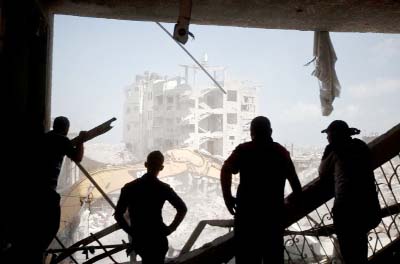
AFP, Gaza City :
Struck in an Israeli air raid in the 2014 Gaza war, Mohammed’s home was only recently rebuilt but he remains undaunted by the prospect of another showdown with the Jewish state.
“I’m not afraid of Israel,” the 35-year-old father of six said while seated on floor cushions in his home in the Zeitoun neighbourhood of Gaza City, his children occasionally peeking their heads around the door.
The member of the leftist Democratic Front for the Liberation of Palestine (DFLP) said preparations for another war have included rebuilding attack tunnels destroyed by Israel two years ago.
As a wave of Palestinian stabbings, shootings and car-rammings have shaken the West Bank and Israel, the Gaza Strip has remained relatively calm.
But increasingly belligerent rhetoric from both Israel and Hamas, the Islamist group that rules Gaza, along with the reconstruction of tunnels the Jewish state says could be used to attack it, have renewed fears of yet another conflict in the enclave still recovering from the 2014 war.
In many ways, another confrontation with the Israeli military would be the last thing the Gaza Strip needs — there have been three since 2008.
Around 100,000 people are still displaced and the unemployment rate is among the world’s highest.
An Israeli blockade has been in place for nearly a decade, tightly restricting the movement of goods and the 1.8 million Gazans.
Beyond that, a more radical strain of Islam has taken root, with Hamas seeking to limit the influence of Salafist jihadists who sympathise with the Islamic State group and who have claimed responsibility for recent rocket fire toward Israel.
All of it deeply concerns those involved in rebuilding Gaza.
Robert Piper, the UN’s deputy special coordinator for the Middle East peace process, told AFP after a recent visit that it “remains on a frankly disastrous trajectory of de-development and radicalisation, as far as I can tell”.
The deadly January 26 collapse of a tunnel belonging to Hamas’s armed wing, the Ezzedine al-Qassam Brigades, as well as another on February 2 drew fresh scrutiny of the movement’s intentions.
The tunnels have been used to store weapons and stage attacks in the past, with Hamas officials saying they are necessary to defend against Israel’s firepower.
In 2006, a group of militants entered Israel through a tunnel, seized Israeli soldier Gilad Shalit and smuggled him back to Gaza, resulting five years later in a prisoner exchange that saw more than 1,000 walk out of Israeli jails.
Struck in an Israeli air raid in the 2014 Gaza war, Mohammed’s home was only recently rebuilt but he remains undaunted by the prospect of another showdown with the Jewish state.
“I’m not afraid of Israel,” the 35-year-old father of six said while seated on floor cushions in his home in the Zeitoun neighbourhood of Gaza City, his children occasionally peeking their heads around the door.
The member of the leftist Democratic Front for the Liberation of Palestine (DFLP) said preparations for another war have included rebuilding attack tunnels destroyed by Israel two years ago.
As a wave of Palestinian stabbings, shootings and car-rammings have shaken the West Bank and Israel, the Gaza Strip has remained relatively calm.
But increasingly belligerent rhetoric from both Israel and Hamas, the Islamist group that rules Gaza, along with the reconstruction of tunnels the Jewish state says could be used to attack it, have renewed fears of yet another conflict in the enclave still recovering from the 2014 war.
In many ways, another confrontation with the Israeli military would be the last thing the Gaza Strip needs — there have been three since 2008.
Around 100,000 people are still displaced and the unemployment rate is among the world’s highest.
An Israeli blockade has been in place for nearly a decade, tightly restricting the movement of goods and the 1.8 million Gazans.
Beyond that, a more radical strain of Islam has taken root, with Hamas seeking to limit the influence of Salafist jihadists who sympathise with the Islamic State group and who have claimed responsibility for recent rocket fire toward Israel.
All of it deeply concerns those involved in rebuilding Gaza.
Robert Piper, the UN’s deputy special coordinator for the Middle East peace process, told AFP after a recent visit that it “remains on a frankly disastrous trajectory of de-development and radicalisation, as far as I can tell”.
The deadly January 26 collapse of a tunnel belonging to Hamas’s armed wing, the Ezzedine al-Qassam Brigades, as well as another on February 2 drew fresh scrutiny of the movement’s intentions.
The tunnels have been used to store weapons and stage attacks in the past, with Hamas officials saying they are necessary to defend against Israel’s firepower.
In 2006, a group of militants entered Israel through a tunnel, seized Israeli soldier Gilad Shalit and smuggled him back to Gaza, resulting five years later in a prisoner exchange that saw more than 1,000 walk out of Israeli jails.

